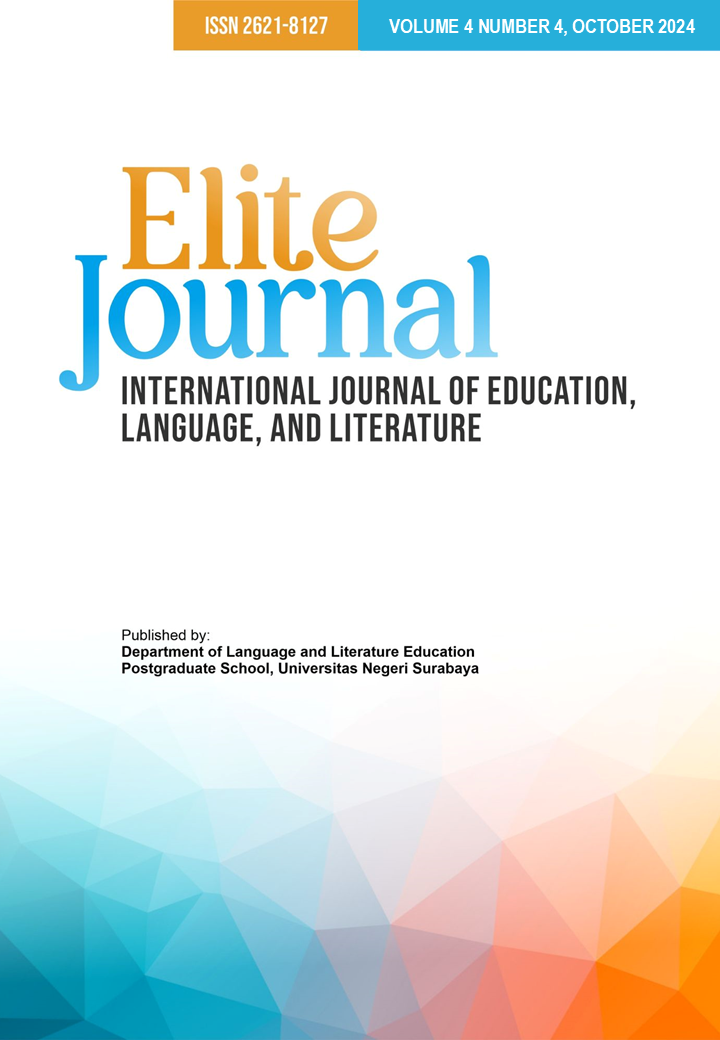URBAN IDENTITY AND EMOTIONAL DISTANCE: HOFSTEDE’S CULTURAL VALUES DIMENSIONS ON APT BY BRUNO MARS AND ROSÉ
DOI:
https://doi.org/10.26740/elitejournal.v4n4.p23-30Keywords:
collectivism and individualism, power distance, uncertainty avoidance, femininityAbstract
This study examines the song APT by ROSÉ and Bruno Mars using Hofstede’s cultural value dimensions to analyze how the lyrics represent the complexities of urban life and cultural identity. The song’s metaphor of the apartment (아파트) symbolizes both physical closeness and emotional distance, highlighting the tension between collectivist and individualist values, power distance, uncertainty avoidance, femininity in modern cities. Through its bilingual lyrics, the song bridges cultural divides and addresses universal themes of emotional longing and isolation. The analysis reveals how the song challenges traditional norms, promoting egalitarian relationships and emphasizing spontaneity over stability, which contrasts with South Korea’s traditional high uncertainty avoidance. The conclusion of this analysis is APT offers insight into the evolving cultural dynamics of South Korea, showing how the song blends local and global influences while resonating with audiences through its exploration of connection, freedom, and modern relationships.
References
Fougère, M., & Moulettes, A. (2008). The construction of the modern West and the backward
Rest: Studying the discourse of Hofstede's Culture's Consequences. Multicultural
Discourses, 3(1), 1–19. https://doi.org/10.2167/md051.0
Hamamura, T., Bettache, K., & Xu, Y. (2018). Individualism and collectivism. In V. Zeigler-
Hill & T. K. Shackelford (Eds.), The SAGE handbook of personality and individual
differences: Origins of personality and individual differences (pp. 365–382). Sage Reference. https://doi.org/10.4135/9781526451200.n20
Hofstede, G. (2001). Culture's consequences: Comparing values, behaviors, institutions, and
organizations across nations (2nd ed.). Sage Publications.
Hofstede Insights. (2023). Understanding national cultures through Hofstede's dimensions.
Retrieved from https://www.hofstede-insights.com
Kim, M.-S. (2008). Our culture, their culture and beyond: Further thoughts on ethnocentrism
in Hofstede's discourse. Multicultural Discourses, 3(1), 26–31. https://doi.org/10.2167/md051c.2
Luthar, V. K., & Luthar, H. K. (2002). Using Hofstede's cultural dimensions to explain
sexually harassing behaviours in an international context. The International Journal
of Human Resource Management, 13(2), 268–284.
https://doi.org/10.1080/09585190110102378
Rinne, T., Steel, G. D., & Fairweather, J. (2013). The role of Hofstede's individualism in
national-level creativity. Creativity Research Journal, 25(1), 129–136.
https://doi.org/10.1080/10400419.2013.752293
Signorini, P., Wiesemes, R., & Murphy, R. (2009). Developing alternative frameworks for
exploring intercultural learning: A critique of Hofstede's cultural difference model.
Teaching in Higher Education, 14(3), 253–264.
https://doi.org/10.1080/13562510902898825
Tan, S. K. (2015). The Role of Korean Collectivism in South Korea’s Industrialization
Process. WILAYAH: The International Journal of East Asian Studies, 4(1), 35–48.
https://doi.org/10.22452/vol4no1.4
Trompenaars, F., & Hampden-Turner, C. (2020). Riding the waves of culture: Understanding
cultural diversity in business (4th ed.). Nicholas Brealey Publishing.
Downloads
Published
How to Cite
Issue
Section
License
Copyright (c) 2024 Ayu Saraswati

This work is licensed under a Creative Commons Attribution 4.0 International License.
 Abstract views: 257
,
Abstract views: 257
, PDF Downloads: 152
PDF Downloads: 152





